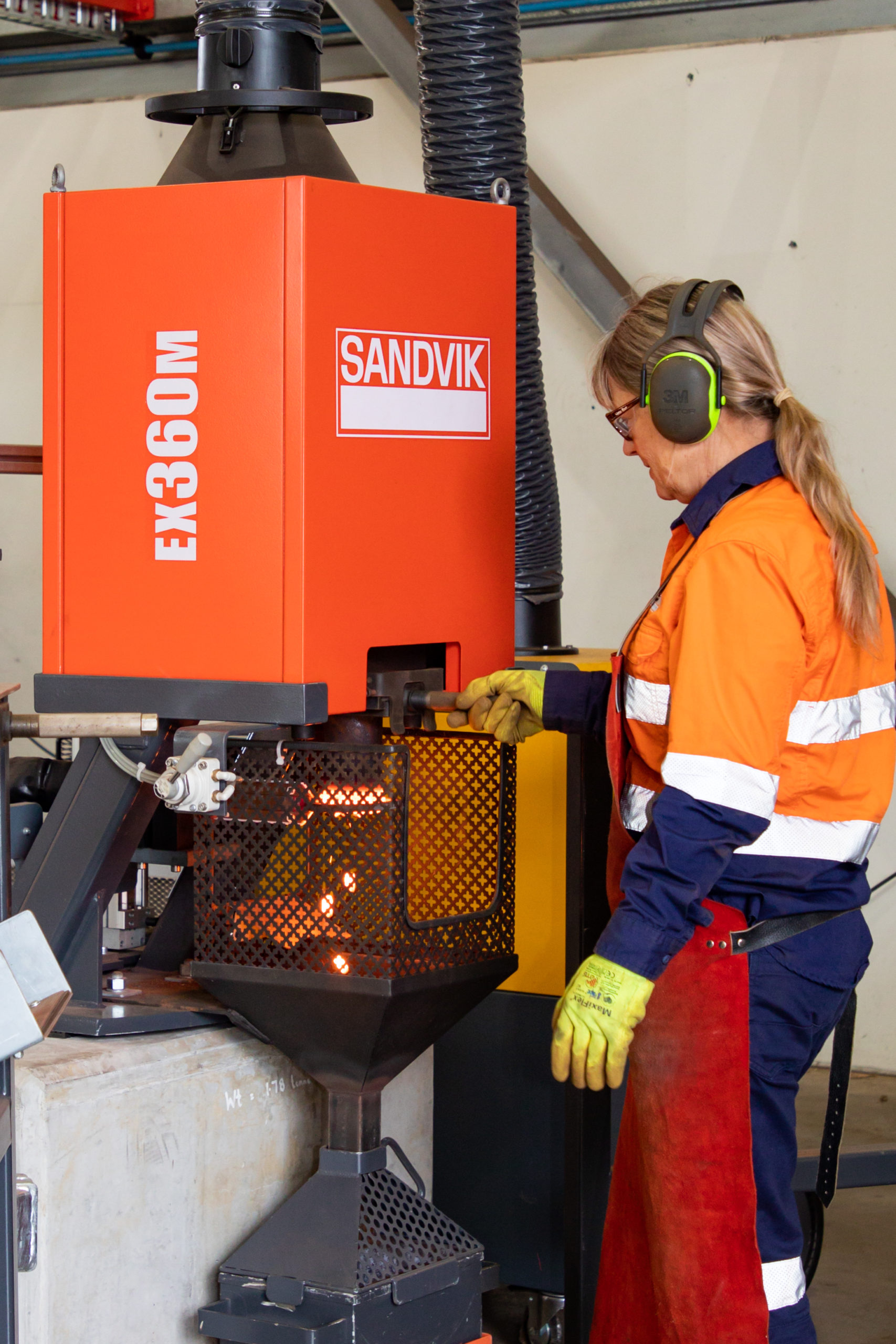Giving New Life to Old Tools
Having developed its own unique extraction technology, Sandvik Rock Tools can now offer an industry-leading recycling program for used drill bits. And by participating, customers can help generate significant reductions in CO2 emissions and preserve scarce resources.
AT THE CURRENT rate of consumption, the world’s supply of tungsten, a key component in cemented carbide, is expected to be depleted in as little as 40 to 100 years. At the same time, the whole mining industry is under increasing pressure to reduce waste and lower CO2 emissions across the value chain.
“We’re serious about sustainability, and that means taking responsibility for our products through their life cycles and contributing to a more circular economy,” says Dean Kangleas, Vice President, Rock Tools Services. “At the moment, we don’t know how to drill without tungsten, so it’s also important that we protect that source. For both these reasons, we’ve really stepped up our recycling efforts in recent years and can now recycle our drill bits to an extent that is unmatched by any other OEM in the mining industry.”
Recycling carbide is not new, and Sandvik Rock Tools has been offering a recycling service for over a decade. However, the traditional process for extracting carbide from the steel drill bits is overly cumbersome and time consuming. For one, the entire drill bit has to be shipped to an extraction plant, and given that the carbide only accounts for around seven to ten percent of the drill bit’s total weight, this means a lot of additional weight has to be shipped. Secondly, the extraction process itself is slow and hazardous, and the resulting carbide is generally of substandard quality when recycled with the old process.
“We realized that if recycling was to really gain traction, we needed to find an easier way to extract the carbide from the steel body, and we needed to bring the process closer to the source,” says Dean. “If we could do this, it would significantly reduce the weight of material that needed to be shipped. It would also help create employment opportunities in the local communities where our customers operate, which is also important to us.”
This challenge led Sandvik Rock Tools to design and develop its own extraction machine in-house, which could easily be relocated and installed on or near a customer’s site. It uses a combination of high-frequency induction heating and vibration to heat the drill bit before shaking out the carbide – a process that is far safer and more effective than the previous manual method.
Once the extraction is complete, the steel – which accounts for around 90-93 percent of the drill bit’s weight – can be sent to a local recycling facility, while the carbide is shipped to Austria for processing. In contrast to the previous extraction method, which saw the entire drill bit being shipped, this represents a significant reduction in the loads being shipped with corresponding reductions in emissions from transportation.
Concurrently, Sandvik Rock Tools has also been working closely with Wolfram Bergbau und Hütten AG, a Sandvik-owned company and supplier of tungsten powders, to develop a new chemical process for recycling the carbide that can break it down to raw tungsten and cobalt in virtually virgin state. The resultant raw materials are 100 percent recyclable and can be returned to production to manufacture new drill bits and tools.
“Our extraction machines, and this new recycling process, are unique to Sandvik,” says Dean. “We are now the only OEM who can extract carbide locally at a customer’s site, and then recycle it back down to virgin material.”
FIVE BENEFITS OF SANDVIK ROCK TOOLS’ RECYCLING PROGRAM
- Manufacturing tools from recycled carbide consumes 70 percent less energy compared to mined carbide.
- The process emits 64 percent less CO2.
- Recycling tools helps preserve scarce raw materials, most notably tungsten.
- Extracting carbide locally means a huge reduction in shipments and transportation, and by extension associated emissions.
- Local extraction generates employment opportunities and economic growth in local communities.
HAVING DEVELOPED THE technology and the processes, the next innovation from Sandvik Rock Tools was to introduce the industry’s first ‘opt-out’ recycling program. While in the past, customers had to sign up for tool recycling, now it is automatically included in any sales agreement.
TUNGSTEN
Tungsten is a rare metal that’s almost exclusively found naturally occurring on Earth in compound with other materials.
“Basically, all customers have to do is collect the old drill bits and deposit them in the bins that we provide – and we’ll take care of the rest,” explains Dean. “We collect them and we pay them for the scrap metal at market rates. We’re also happy to purchase competitors’ drill bits from them too. The customer is not required to do anything else but can rest easy knowing that they’re contributing to improving their own sustainability impact and that their old tools are entering into a circular economy.”
IT IS ESTIMATED that making tools from recycled carbide consumes 70 percent less energy compared to mined carbide, and that the process emits 64 percent less CO2. Sandvik Rock Tools’ ambition is to collect 90 percent of its drill bits by 2025. If successful, this will save around 4500 metric tons of CO2 per year as well as significantly reduce the amount of raw materials consumed in the production of new tools. It will also play an important role in helping Sandvik meet its ambition to reduce its CO2 emissions by 50 percent by 2030.
Furthermore, for participating customers, the CO2 savings generated by the recycling program can be used when calculating their own carbon footprints too.
“Recycling drill bits and bringing them back into the circular economy contributes to reducing customers’ emissions,” says Dean. “The message that we’re getting from our customers is that sustainability is just as important to them as it is to us, and a lot of them have ambitious targets of their own. They’re so excited by our program, and we expect to see it generate a lot of traction in the coming years.”
HOW IT WORKS
Sandvik Rock Tools’ recycling program is designed to make the process as simple as possible for the customer.
- Customers discard used drill bits in bins provided by Sandvik Rock Tools.
- Sandvik Rock Tools collects the drill bits and pays the customer for the scrap metal. This includes competitors’ drill bits too.
- The drill bits are taken to the closest extraction machine, which could potentially even be located on the customer’s site.
- The carbide is extracted from the drill bit’s steel body. The carbide is shipped to the recycling plant in Austria, while the steel is sent to a local recycling facility.
- The carbide is broken down into raw tungsten and cobalt. The quality of the raw material is virtually on par with virgin material.
- The tungsten and cobalt are returned to Sandvik Rock Tools’ production and used to manufacture new drill bits.
- The recycled drill bits are sold to customers, thus completing the circle.

/https%3A%2F%2Fsolidground.sandvik%2Fwp-content%2Fuploads%2F2023%2F05%2FRecycling_Factory_Stills1_2023.jpg)


/https%3A%2F%2Fsolidground.sandvik%2Fwp-content%2Fuploads%2F2023%2F05%2FRecycling_Factory_Stills1_2023.jpg)
/https%3A%2F%2Fsolidground.sandvik%2Fwp-content%2Fuploads%2F2023%2F01%2Ftundo_rh650_keyvisual_2_2500px.jpg)
/https%3A%2F%2Fsolidground.sandvik%2Fwp-content%2Fuploads%2F2021%2F11%2FTHXL_Key_visual_3.0_1600x570.jpg)
/https%3A%2F%2Fsolidground.sandvik%2Fwp-content%2Fuploads%2F2019%2F09%2FRammer-5011-quarrying_41879_1600x570.jpg)
/https%3A%2F%2Fsolidground.sandvik%2Fwp-content%2Fuploads%2F2019%2F06%2FSG_cover_1600x570.jpg)
/https%3A%2F%2Fsolidground.sandvik%2Fwp-content%2Fuploads%2F2016%2F12%2Fdeadline-defeated_1366x450.jpg)
/https%3A%2F%2Fsolidground.sandvik%2Fwp-content%2Fuploads%2F2015%2F02%2FHoF1.jpg)
/https%3A%2F%2Fsolidground.sandvik%2Fwp-content%2Fuploads%2F2014%2F12%2FBorynia_094.jpg)
/https%3A%2F%2Fsolidground.sandvik%2Fwp-content%2Fuploads%2F2014%2F12%2FJSW_Poland2.jpg)
/https%3A%2F%2Fsolidground.sandvik%2Fwp-content%2Fuploads%2F2014%2F05%2FMcArthur_Tara1.jpg)
/https%3A%2F%2Fsolidground.sandvik%2Fwp-content%2Fuploads%2F2014%2F04%2Fkanadagruva11.jpg)
/https%3A%2F%2Fsolidground.sandvik%2Fwp-content%2Fuploads%2F2014%2F04%2Fkanadagruva021.jpg)